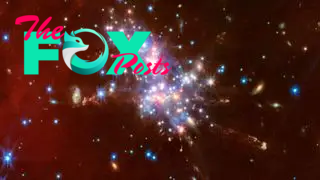Science
James Webb Telescope goes 'extreme' and spots baby stars at the edge of the Milky Way (image)
The James Webb Space Telescope (JWST) has been no stranger to taking things to the extreme since its launch on Christmas day 2021, observing early galaxies billions of light-years away that existed when the universe was at a fraction of its currently 13.8 billion-year life.
Now, the powerful space telescope has pushed it to the edge closer to home in our very own galaxy, the Milky Way. A team of astronomers has pointed the JWST at the outskirts of the Milky Way, observing a region scientists call the "Extreme Outer Galaxy."
This area is about 58,000 light-years from the heart of the Milky Way, or "Galactic Center." For comparison, the solar system is located just under halfway between the Galactic Center and the very edge of the Milky Way. That distance is just 26,000 light-years, so when we say "extreme edge" for these new observations, that's more than hyperbole! The result of this galactic envelope-pushing exercise is a stunning image of star clusters in the midst of a "starburst" and an intense period of rapid star birth.
"In the past, we knew about these star-forming regions but were not able to delve into their properties," steam leader Natsuko Izumi of Gifu University and the National Astronomical Observatory of Japan said in a statement. "The JWST data builds upon what we have incrementally gathered over the years from prior observations with different telescopes and observatories. We can get very powerful and impressive images of these clouds with the JWST."
The Milky Way star birthing regions seen by the team using the JWST's Near-Infrared Camera (NIRCam) and Mid-Infrared Instrument (MIRI) are enveloped within dense and vast conglomerations of gas called "molecular clouds." The two molecular clouds in question are designated Digel Cloud 1 and Digel Cloud 2, which are many light-years long and are now imaged in unprecedented detail.
Related: 35 jaw-dropping James Webb Space Telescope images

Among the elements of these clusters visible in the images are extremely young protostars. These are stellar bodies that haven't yet gathered enough material from the prenatal cocoons of gas and dust to pile on mass to trigger the nuclear fusion of hydrogen to helium in their cores, the process that defines what an adult or "main sequence" star is.
As any parent who has ended up with baby food in their hair will tell you, all infants are prone to tantrums, and these protostars are no different. But these ejections aren't Gerber strawberry and banana puree (tasty and great for the hair); they are jets and outflows of superheated gas called "plasma." Evidence of these stellar tantrums is also visible in the new JWST image.
-

 Science1d ago
Science1d agoInside Capitol Hill’s Latest UFO Hearings
-

 Science1d ago
Science1d agoYou Won’t Want to Miss the Leonid Meteor Shower. Here’s How and When You Can See It
-

 Science2d ago
Science2d agoHere’s What Trump’s Win Means for NASA
-

 Science5d ago
Science5d agoWhy Risky Wildfire Zones Have Been Increasing Around the World
-

 Science6d ago
Science6d agoIt’s Time to Redefine What a Megafire Is in the Climate Change Era
-

 Science1w ago
Science1w ago4 Astronauts Return to Earth After Being Delayed by Boeing’s Capsule Trouble and Hurricane Milton
-

 Science1w ago
Science1w agoThe Elegance and Awkwardness of NASA’s New Moon Suit, Designed by Axiom and Prada
-

 Science1w ago
Science1w agoSpaceX Launches Its Mega Starship Rocket. This Time, Mechanical Arms Catch It at Landing


























